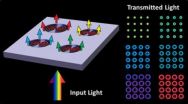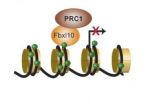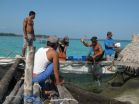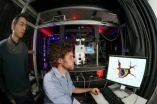(Press-News.org) CHESTNUT HILL, MA (February 7, 2013) – Using the geometric and material properties of a unique nanostructure, Boston College researchers have uncovered a novel photonic effect where surface plasmons interact with light to form "plasmonic halos" of selectable output color. The findings appear in the journal Nano Letters.
The novel nanostructure proved capable of manipulating electron waves known as surface plasmon polaritons, or SPPs, which were discovered in the 1950s but of late have garnered the attention of scientists for their potential applications in fields that include waveguiding, lasing, color filtering and printing.
The team put a layer of a polymer film on a glass substrate and then dotted the surface with holes precisely defined by a process of electron beam lithography, using the BC Integrated Sciences Nanofabrication Clean Room facility. The team next applied a layer of silver, thick enough to be nontransparent to visible light. In addition to covering the thin film on top, the silver coated the contours of the holes in the film, as well as the exposed circles of the glass substrate below. The effect produced an array of silver microcavities.
When the researchers directed light from below and through the glass substrate, light "leaking" through nanoscale gaps on the perimeters of the microcavities created SPP waves on their top surfaces. At particular wavelengths of the incident light, these waves formed modes or resonances analogous to acoustic waves on a drumhead, which in turn effectively filtered the light transmitted to the far side, accounting for the "halo" appearance, said Boston College Ferris Professor of Physics Michael Naughton, who co-authored the report with Senior Research Associate Michael J. Burns and doctoral student and lead author Fan Ye. The team's research was funded by the W. M. Keck Foundation.
Central to this control effect are "step gaps" formed along the perimeter of each circle, which give the nanostructure the ability to modulate which waves of light pass through. It is within this geometry that the interaction of light upon the silver surface coating resulted in the excitation of plasmon waves, said Naughton. Examination of the SPPs by Mr. Ye using a near-field scanning optical microscope offered unique insights into the physics at work within the structure, Naughton said.
By adjusting the type of metal used to coat the structure or varying the circumferences of the microcavities, Naughton said the step-gap structure is capable of manipulating the optical properties of the device in the visible light range, giving the researchers newfound control in light filtering.
This kind of control, the team reports, could have applications in areas such as biomedical plasmonics or discrete optical filtering.
INFORMATION:
The report is available at: http://pubs.acs.org/doi/full/10.1021/nl303955x
Boston College researchers' unique nanostructure produces novel 'plasmonic halos'
Nanoscopic microcavities offer newfound control in light filtering
2013-02-08
ELSE PRESS RELEASES FROM THIS DATE:
Specific warning signs of complications in colorectal surgical patients released
2013-02-08
Chicago (February 7, 2013): Colorectal surgical patients are often discharged from the hospital with vague guidance on how to recognize complications, but researchers at the Michael DeBakey Veterans Administration (VA) Medical Center and Baylor College of Medicine, Houston, aim to change that scenario. A health services research team convened a panel of surgical experts to develop a list of postoperative complication signs that should prompt colorectal surgical patients to call their surgeons or go to an emergency room. The study on the development of this early patient-centered ...
Dickkopf makes fountain of youth in the brain run dry
2013-02-08
The hippocampus – a structure of the brain whose shape resembles that of a seahorse – is also called the "gateway" to memory. This is where information is stored and retrieved. Its performance relies on new neurons being continually formed in the hippocampus over the entire lifetime. "However, in old age, production of new neurons dramatically decreases. This is considered to be among the causes of declining memory and learning ability", Prof. Dr. Ana Martin-Villalba, a neuroscientist, explains.
Martin-Villalba, who heads a research department at the German Cancer Research ...
Scientists find key to growth of 'bad' bacteria in inflammatory bowel disease
2013-02-08
(SACRAMENTO, Calif.) — Scientists have long puzzled over why "bad" bacteria such as E. coli can thrive in the guts of those with inflammatory bowel disease (IBD), causing serious diarrhea. Now UC Davis researchers have discovered the answer—one that may be the first step toward finding new and better treatments for IBD.
The researchers discovered a biological mechanism by which harmful bacteria grow, edge out beneficial bacteria and damage the gut in IBD. This new understanding, published in the Feb. 8 issue of Science, may help researchers develop new treatments for ...
Experimental gene therapy treatment for Duchenne muscular dystrophy offers hope for youngster
2013-02-08
Jacob Rutt is a bright 11-year-old who likes to draw detailed maps in his spare time. But the budding geographer has a hard time with physical skills most children take for granted -- running and climbing trees are beyond him, and even walking can be difficult. He was diagnosed with a form of muscular dystrophy known as Duchenne when he was two years old.
The disease affects about 1 in 3,500 newborns -- mostly boys -- worldwide. It usually becomes apparent in early childhood, as weakened skeletal muscles cause delays in milestones such as sitting and walking. Children ...
Protein paves the way for correct stem cell differentiation
2013-02-08
A single embryonic stem cell can develop into more than 200 specialized cell types that make up our body. This maturation process is called differentiation and is tightly regulated. If the regulation is lost, specialized cells cannot develop correctly during development. In adulthood, the specialized cells may forget their identity and develop into cancer cells. Research from BRIC, University of Copenhagen, has identified a crucial role of the molecule Fbxl10 in differentiation of embryonic stem cells and suggests the molecule as a new potential target for cancer therapy.
"Our ...
USC research finds certain contraceptive may pose risk of Type 2 diabetes for obese women
2013-02-08
Highlights of this news release:
Six-month study finds that progestin-releasing contraceptives show a slight negative impact on metabolic markers, raising the risk for type 2 diabetes.
Contraceptive implants under the skin increase the risk more than uterine implants.
Longer and larger studies are needed to see if metabolic changes are temporary or long-term.
LOS ANGELES – A first-of-its-kind study by researchers at the Keck School of Medicine of the University of Southern California (USC) indicates that healthy, obese, reproductive-age women who use long-acting ...
Indonesian fishing communities find balance between biodiversity and development
2013-02-08
Fishing communities living on the islands of Indonesia's Karimunjawa National Park have found an important balance, improving their social well-being while reducing their reliance on marine biodiversity, according to the Wildlife Conservation Society and the University of Western Australia.
Over the past 5 years, the Government of Indonesia has turned Karimunjawa National Park—a marine paradise of turquoise seas and mangrove-ringed islands in the Java Sea just south of Borneo—into a model of co-management for the country, largely by increasing community participation ...
By their powers combined
2013-02-08
ARGONNE, Ill. – Although scientists have been aware that magnetism and electricity are two sides of the same proverbial coin for almost 150 years, researchers are still trying to find new ways to use a material's electric behavior to influence its magnetic behavior, or vice versa.
Thanks to new research by an international team of researchers led by the U.S. Department of Energy's Argonne National Laboratory, physicists have developed new methods for controlling magnetic order in a particular class of materials known as "magnetoelectrics."
Magnetoelectrics get their ...
Triple-negative breast cancer subtypes identified using microRNA
2013-02-08
Triple-negative breast cancer is an aggressive form of breast cancer that has few treatment options;
This large-scale study shows that abnormal levels of small molecules called microRNA can be used to classify this malignancy into four subtypes;
The findings could lead to new ways to identify the best therapy for individual patients and to more effective therapies in the future.
COLUMBUS, Ohio – A new, large-scale study of triple-negative breast cancer shows that small molecules called microRNA can be used to define four subtypes of this aggressive malignancy.
The ...
Peering into living cells -- without dye nor fluophore
2013-02-08
In the world of microscopy, this advance is almost comparable to the leap from photography to live television. Two young EPFL researchers, Yann Cotte and Fatih Toy, have designed a device that combines holographic microscopy and computational image processing to observe living biological tissues at the nanoscale. Their research is being done under the supervision of Christian Depeursinge, head of the Microvision and Microdiagnostics Group in EPFL's School of Engineering.
Using their setup, three-dimensional images of living cells can be obtained in just a few minutes ...
LAST 30 PRESS RELEASES:
Making lighter work of calculating fluid and heat flow
Normalizing blood sugar can halve heart attack risk
Lowering blood sugar cuts heart attack risk in people with prediabetes
Study links genetic variants to risk of blinding eye disease in premature infants
Non-opioid ‘pain sponge’ therapy halts cartilage degeneration and relieves chronic pain
AI can pick up cultural values by mimicking how kids learn
China’s ecological redlines offer fast track to 30 x 30 global conservation goal
Invisible indoor threats: emerging household contaminants and their growing risks to human health
Adding antibody treatment to chemo boosts outcomes for children with rare cancer
Germline pathogenic variants among women without a history of breast cancer
Tanning beds triple melanoma risk, potentially causing broad DNA damage
Unique bond identified as key to viral infection speed
Indoor tanning makes youthful skin much older on a genetic level
Mouse model sheds new light on the causes and potential solutions to human GI problems linked to muscular dystrophy
The Journal of Nuclear Medicine ahead-of-print tip sheet: December 12, 2025
Smarter tools for peering into the microscopic world
Applications open for funding to conduct research in the Kinsey Institute archives
Global measure underestimates the severity of food insecurity
Child survivors of critical illness are missing out on timely follow up care
Risk-based vs annual breast cancer screening / the WISDOM randomized clinical trial
University of Toronto launches Electric Vehicle Innovation Ontario to accelerate advanced EV technologies and build Canada’s innovation advantage
Early relapse predicts poor outcomes in aggressive blood cancer
American College of Lifestyle Medicine applauds two CMS models aligned with lifestyle medicine practice and reimbursement
Clinical trial finds cannabis use not a barrier to quitting nicotine vaping
Supplemental nutrition assistance program policies and food insecurity
Switching immune cells to “night mode” could limit damage after a heart attack, study suggests
URI-based Global RIghts Project report spotlights continued troubling trends in worldwide inhumane treatment
Neutrophils are less aggressive at night, explaining why nighttime heart attacks cause less damage than daytime events
Menopausal hormone therapy may not pose breast cancer risk for women with BRCA mutations
Mobile health tool may improve quality of life for adolescent and young adult breast cancer survivors
[Press-News.org] Boston College researchers' unique nanostructure produces novel 'plasmonic halos'Nanoscopic microcavities offer newfound control in light filtering



